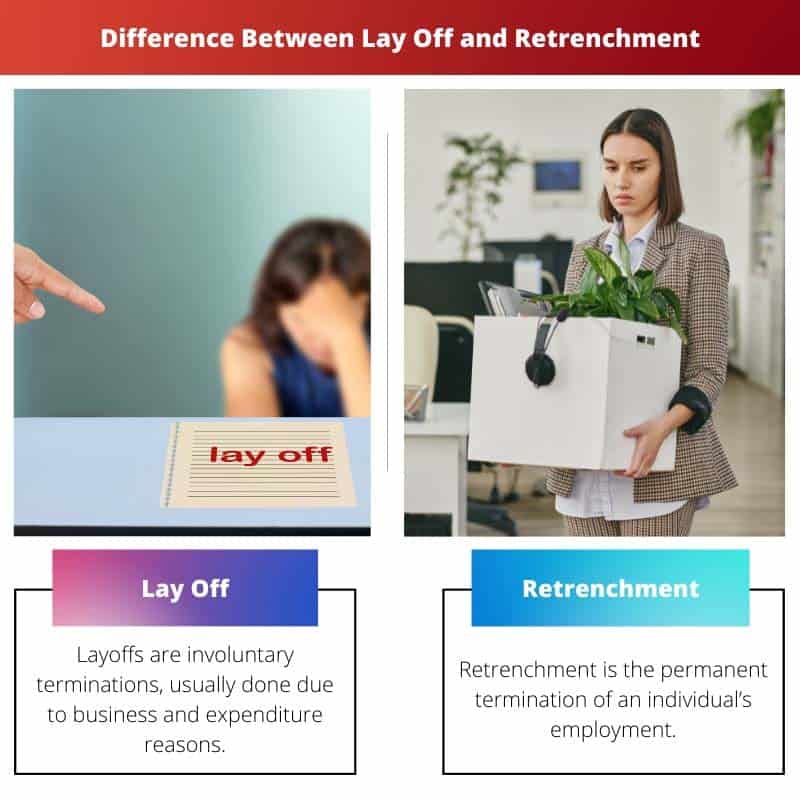Layoff and retrenchment both refer to the reduction of a company’s workforce, but they differ in scope and intent. Layoffs typically involve temporary workforce reductions due to factors like seasonal fluctuations or financial constraints, with the possibility of rehiring when conditions improve. Retrenchment, on the other hand, is a more permanent and strategic measure, often driven by long-term financial difficulties or organizational restructuring, leading to a lasting reduction in workforce size.
Key Takeaways
- A layoff is a temporary or permanent separation of employees from a company, due to economic downturns, restructuring, or cost-cutting measures.
- Retrenchment is a broader term that includes layoffs but also covers other cost-cutting strategies, such as reducing spending, eliminating non-essential operations, or selling assets.
- Layoffs focus specifically on workforce reduction, while retrenchment encompasses a wider range of cost-saving measures that may or may not include layoffs.
Lay Off vs Retrenchment
The difference between layoffs and reduction is that layoffs can be temporary, while reduction is permanent termination.

Involuntary terminations can be further divided into two broad categories: Layoffs and Retrenchment. Layoffs are a part of business terminations that are volatile.
This means that once the lean period for the organization is over, the employed might be called back to work.
Retrenchment is another form of termination which is not dependent on the employee’s actions. Retrenchment, however, is non-volatile, meaning that employees will never be called back once terminated.
Comparison Table
| Feature | Layoff | Retrenchment |
|---|---|---|
| Termination | Temporary | Permanent |
| Expectation of Recall | Possible | Not Likely |
| Reason | Short-term economic difficulties, lack of work | Long-term strategic restructuring, downsizing |
| Notice Period | May or may not be required | Required by law |
| Severance Pay | May be offered | May be required by law or offered depending on company policy |
| Impact on Employer-Employee Relationship | May continue | Ceases to exist |
What is Lay Off?
Reasons for Layoffs
Economic Downturn
In times of economic instability, companies may resort to layoffs to manage financial challenges, ensuring sustainability during tough periods.
Organizational Restructuring
Companies may reorganize their structure to enhance efficiency, resulting in the elimination of certain positions and roles.
Technological Advancements
Automation and technological advancements can lead to job redundancies, prompting companies to lay off employees whose roles become obsolete.
Mergers and Acquisitions
During mergers or acquisitions, organizations may eliminate duplicate positions to streamline operations and reduce costs.
Legal Considerations
Worker Adjustment and Retraining Notification (WARN) Act
In some jurisdictions, companies are required to provide advance notice to employees and government authorities before implementing large-scale layoffs.
Severance Packages
Employers may offer severance packages to laid-off employees, including financial compensation, benefits continuation, and career transition assistance.
Discrimination and Fair Treatment
Laws prohibit discriminatory layoffs based on race, gender, age, or other protected characteristics. Ensuring fair treatment during layoffs is essential to avoid legal consequences.
Employee and Employer Perspectives
Employee Impact
Layoffs can have significant emotional and financial implications for employees, leading to stress, anxiety, and job insecurity.
Employer Considerations
Employers must weigh the short-term benefits of layoffs against potential long-term consequences, such as damage to morale, reputation, and employee loyalty.
Alternatives to Layoffs
Workforce Re-training
Investing in re-training programs can help employees acquire new skills, making them adaptable to evolving job requirements.
Reduced Work Hours
Implementing reduced work hours or furloughs may be an alternative to complete layoffs, providing financial relief to the company while retaining skilled employees.
Cross-Training
Cross-training employees to perform multiple roles can enhance workforce flexibility, reducing the need for layoffs during fluctuations in workload.

What is Retrenchment?
Reasons for Retrenchment
Economic Downturn
During economic downturns, businesses may face reduced demand, leading to financial constraints. Retrenchment becomes a viable option to cut costs and sustain the organization through challenging times.
Technological Advancements
The rapid evolution of technology can render certain job roles obsolete. Companies may choose retrenchment to streamline operations and integrate new technologies, improving overall efficiency.
Mergers and Acquisitions
In cases of mergers or acquisitions, organizations often reevaluate their workforce to eliminate redundancies and align the combined entity with the new strategic vision.
Restructuring for Efficiency
Retrenchment can be part of a broader restructuring effort to enhance organizational efficiency. This may involve consolidating departments, outsourcing certain functions, or redefining job roles.
Types of Retrenchment
Voluntary Retrenchment
Voluntary retrenchment involves employees willingly accepting a separation package or early retirement. This approach allows organizations to downsize without resorting to forced layoffs, fostering a more positive organizational culture.
Involuntary Retrenchment
Involuntary retrenchment, often known as layoffs or downsizing, occurs when organizations terminate employees due to performance issues, redundancy, or financial constraints. This method is typically a last resort and can negatively impact employee morale.
Temporary Retrenchment
Temporary retrenchment involves a temporary reduction in workforce during periods of low demand or economic downturn. Employees may be laid off with the intention of rehiring them when conditions improve.
Legal and Ethical Considerations
Labor Laws
Companies must adhere to labor laws and regulations governing retrenchment procedures. This includes providing adequate notice, severance packages, and following due process to ensure fair treatment of affected employees.
Communication and Support
Maintaining transparent communication throughout the retrenchment process is essential. Offering support services, such as career counseling or job placement assistance, can help mitigate the impact on affected employees.

Main Differences Between Lay-Off and Retrenchment
- Definition:
- Lay-off: Temporary separation of employees from work due to reasons like lack of work or financial constraints, with the intention of recalling them when conditions improve.
- Retrenchment: Permanent termination of employees’ services by the employer due to reasons such as organizational restructuring, financial difficulties, or a reduction in workforce.
- Duration:
- Lay-off: Temporary and typically short-term, with the expectation of rehiring employees when the situation improves.
- Retrenchment: Permanent, indicating the end of the employment relationship.
- Intent:
- Lay-off: Intended to be a temporary solution to address short-term challenges without permanently severing the employment relationship.
- Retrenchment: Involves a permanent reduction in workforce size, reflecting a long-term adjustment to organizational needs.
- Employee Status:
- Lay-off: Employees are considered on a temporary break from work and may retain certain benefits or rights during the lay-off period.
- Retrenchment: Employees’ services are terminated, leading to the cessation of benefits and rights associated with employment.
- Employer’s Perspective:
- Lay-off: Often seen as a measure to cope with temporary downturns in business and maintain a skilled workforce for future needs.
- Retrenchment: Typically undertaken as a strategic decision to streamline operations, improve efficiency, or address long-term financial challenges.
- Legal Implications:
- Lay-off: Depending on jurisdiction, there may be specific regulations regarding the duration and conditions of lay-offs, including provisions for benefits during the lay-off period.
- Retrenchment: Usually involves adherence to labor laws and regulations governing termination, severance pay, and other employee rights.
- Communication:
- Lay-off: Employers often communicate the temporary nature of the situation and their intention to rehire employees when circumstances improve.
- Retrenchment: Communication may emphasize the permanent nature of the job loss and provide information on severance packages or support services for affected employees.
- Recall:
- Lay-off: Employees are often given priority when the company decides to rehire, considering their experience and skills.
- Retrenchment: Involves the complete severance of the employment relationship, and if needed, new hiring processes are initiated for vacant positions.





